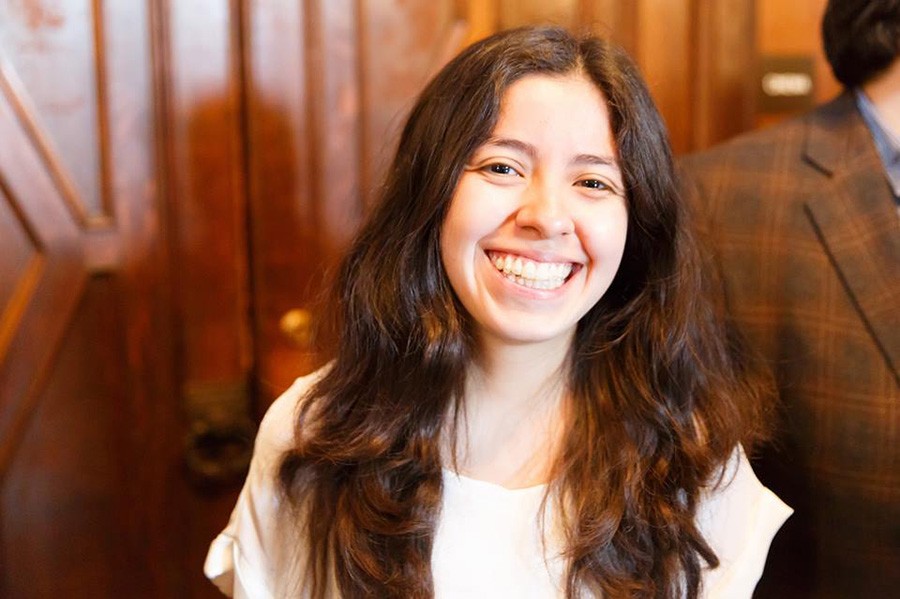CityLab Latino, a joint site of Univision and The Atlantic, recently highlighted 20 young Latino leaders from cities across the country to show how, during an era when the value of immigration is being questioned, "the urban world today needs Latinos." Juan Pablo Garnham interviewed Streetsblog reporter Lynda Lopez, who also works at the Brighton Park Neighborhood Council doing youth outreach and volunteers with Grassroots Illinois Action, about her work to prevent the displacement of low-to-moderate-income Chicagoans from neighborhoods with rising property values, property taxes, and rents, including the area around the Bloomingdale Trail, aka The 606.
Calvin Brown translated the piece into English, below, for publication on Streetsblog Chicago. Read Garnham's piece in the original Spanish on the CityLab Latino site.
"Lynda Lopez: A Young Voice to Stop Displacement" by Juan Pablo Garnham
Lynda Lopez became aware of the problems in her neighborhood by listening to local residents. “When I was in sophomore year of high school, I started writing for a youth newspaper and I started to ask questions, to find out about the problems at my school and in my neighborhood,” says Lynda Lopez, who grew up in Humboldt Park with her mother, an immigrant from Guadalajara.
Today she is only 26, but when she talks about urban and sociological problems, she sounds like someone who has a lot more experience. “I started writing about school closings and that sparked my curiosity. They were issues of inequality and education," says Lopez. "And when you write about schools, what you are really doing is writing about neighborhoods. That’s the way I learned about the city.”
Celebrating our @ThomasKelly_HS & @CurieHS graduating seniors! #kellygoestocollege #curiecondors @BPNCchicago pic.twitter.com/zIbJfE7GEj
— Lynda Lopez (@Lyndab08) June 2, 2017
Little by little she became more involved in citizen activism in Latino neighborhoods in Chicago. During her final year of high school she joined a study group called Future Leaders in Planning – organized by the Chicago Metropolitan Agency for Planning – where she learned about topics such as public transportation and social and environmental justice. Later, while attending the University of Chicago, she was able to see clearly what was happening in that neighborhood on the South Side of the city.
“In Hyde Park, where the university is located, the process of gentrification surrounds you -- my time there made me very conscious of that,” recalls Lopez. Since then she has worked mobilizing the community and participated in a phone hotline, which offers support to neighborhood residents. “People would call to stop evictions or rent increases,” she says. “There you can see how housing instability is affecting our communities.”
In Chicago a number of predominantly Latino neighborhoods are being threatened by rising rents, including Pilsen and Logan Square, where Lopez has worked actively. The problem is that at times what some residents perceive as an improvement negatively affects Hispanics and other minorities.
“There is an elevated path running between Humboldt Park and Wicker Park called the Bloomingdale Trail," Lopez explains. "It opened in June 2015. But many people are worried about the effect it might have on those who live around it and rent increases.”
Together with a group of neighbors, Lopez organized meetings with local residents to inform and prepare them. They created plans and are trying to impede the demolition of houses, something that might happen with the increasing financial value of the neighborhood. She has also organized writing workshops and a neighborhood reading club with the goal of fostering community and neighborhood awareness. “I believe that telling stories is very important,” she says.
These days Lynda Lopez and her neighbors face a major challenge. Over the last 15 years Logan Square has lost 19,000 Hispanics. Lopez is working at the Brighton Park Neighborhood Council, a community organization, lending support to the creation of young leaders, youth employment, and professional development. But her main challenge continues to be answering the question of how to support neighborhood residents and local communities. In fact, in the future she would like to earn a postgraduate degree in urban planning and contribute from that field. “I believe that development can be good, but if only if we take the right measures to accompany it,” says Lopez. “Integration can be positive, but I don’t think the process is being carried out in the best way.”






